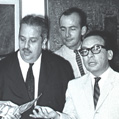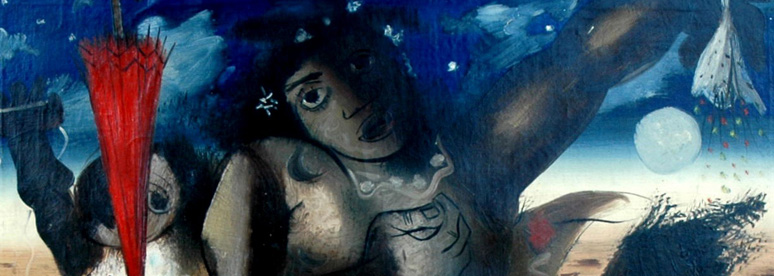PAST EXHIBITION

Facets of the Permanent Collection
Selections from AMA's Collection
April 29, 2009 – August 23, 2009
ABOUT THE EXHIBIT
Facets is a new installation of the permanent collection featuring significant works by Latin American and Caribbean artists which the OAS has acquired since 1949. The more than fifty works exhibited convey in a synthesized fashion a sense of the breadth and strengths of the museum's holdings. Represented in the exhibit are iconic works, such as Alejandro Obregon’s The Dead Student (1956). Awarded a national prize at the 1956 Guggenheim International Exhibition, the painting speaks to the period in Colombian history known as La Violencia
The evolution of the collection has always been strongly tied to the direction of the OAS exhibition program, which responded to specific visual arts developments in OAS member countries at particular moments in time. From the mid-1940s to the early 1980s, the OAS exhibition program was directed by Cuban-born art critic José Gómez-Sicre who played a seminal role in introducing a United States audience to emerging artists of Latin America and the Caribbean, many of whom he knew personally.
On view in the exhibit is the first work to enter the collection, a painting entitled Return from the Fair (1940) by Candido Portinari (Brazilian 1903-1962), donated by Gomez-Sicre in 1949. Portinari, who collaborated on architectural projects with renowned Brazilian architect Oscar Niemeyer, is also well known for his murals, examples of which can be seen in Washington DC at the Hispanic Division of the Library of Congress. Several of the eighteen works donated to the OAS by IBM from its Latin American collection are also featured in the exhibit including The Last Serenade (1937) by Emilio Pettoruti (Argentine 1892-1971), Hibiscus (1943) by Amelia Pelaez and Caribbean Sorcery (1949) by Mario Carreño. The Constructive Composition (1943) by Joaquin Torres Garcia was a gift to the OAS from Nelson Rockefeller. Torres-Garcia‘s influential doctrine of Constructive Universalism was a cornerstone of Latin American modernism. The 1948 painting by Roberto Matta, another pioneer of modernism, was presented to the OAS by the Washington Workshop Center for the Arts.
The museum holds an important collection of Latin American artists of Japanese origin including a significant number of works by members of SEIBI (Japanese Artists Association of Sao Paulo), a group that was influential in the development of abstract informalist trends in Brazil In this exhibit paintings by two SEIBI artists-- Manabu Mabe and Kazuo Wakabayashi -- are on view. Also featured are works by the leading innovators of op art and kinetic art in Venezuela including Color-rhythm 34 (1957-1958) by Alejandro Otero, Hurtado Writing (1975) by Jesus Soto and Physichromie No. 965(1977) by Carlos Cruz Diez. In a constructivist spirit are Edgar Negret’s Magic Gadget ((1959) and a recent gift to the collection in 2006, Marcelo Bonevardi’s Hanging Object (1971) which combines elements of painting and sculpture..
Works by “naive” and “intuitive” artists of the region are an interesting facet of the collection. Victory Dance (1976) by Brother Everald Brown (Jamaican 1917–2002) is example of an aspect of Jamaican art linked to a resurgence of religious movements like Rastafarianism and Revivalism. Brown viewed the creation of art as a spiritual channel through which to visualize and communicate the religious mystical experience. The syncretic Crucifixion (1959) by Georges Liautaud (Haitian 1899–1991) combines elements from Christian and Afro-Caribbean religious beliefs. A blacksmith by profession, Liautaud initially produced utilitarian agricultural tools and iron crosses for the cemetery of his hometown. In the early 1950s, he began producing purely nonutilitarian sculptures from recycled metals—empty gasoline drums or tin sheets—which he cut and perforated.
The museum’s print collection is extensive and several examples are on view in this exhibit including the lithograph Rear Guard (1929) by Mexican muralist Jose Clemente Orozco—the earliest work in the exhibit-- and Child Mother (1956) by muralist David Alfaro Siqueiros Also on exhibit is The Popol Vuh lithographic series (1943) by Carlos Merida inspired in the 16th century Book of Council of the Quiche Maya and a small-format woodcut series by early members of the Haitian Centre d’Art, several of whom were participants in the famous mural cycle at the Cathedral of the Holy Trinity in Port-au-Prince.
Among the relatively more contemporary works in the exhibit is a steel sculpture by Carlos Alfonzo (1950–1991) and Tony Capellan’s (b. 1955) Feverish Interrogations in the Dilemma of the Caribbean (1992), a prize-winner at the First Painting Biennial of the Caribbean and Central America in Santo Domingo. Capellan’s large format "mosaic-painting” poses several rhetorical questions about the function of art and the place of Latin American artists within the "mainstream."
The works stand on their own as outstanding examples of individual artistic expression and at the same time inform about differences and commonalities in the cultural heritage of the region.

